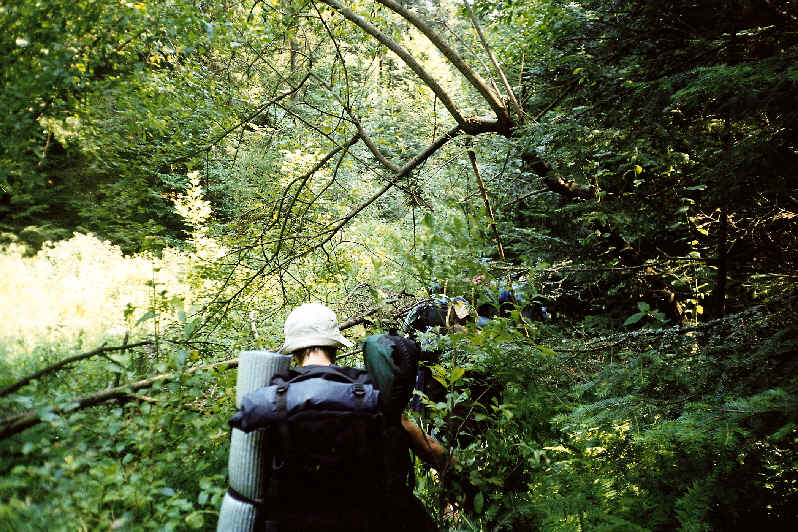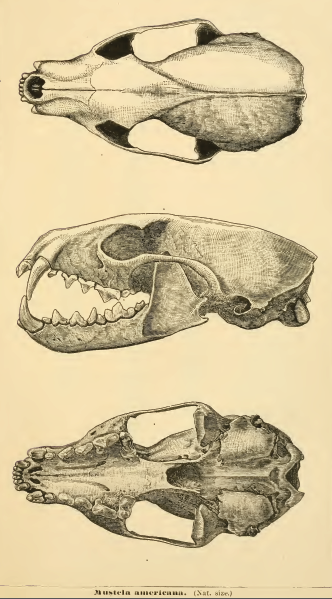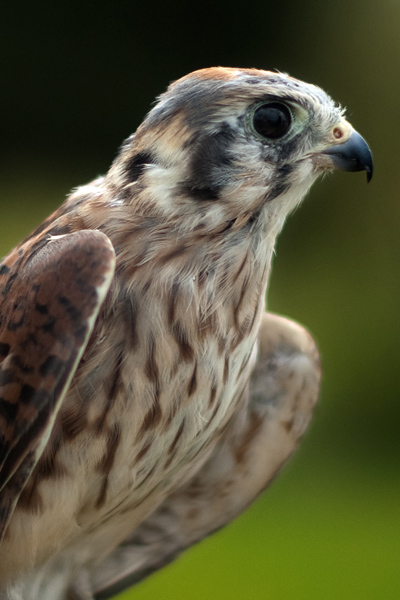|
George H. Crosby Manitou State Park
George H. Crosby Manitou State Park is a state park of Minnesota, USA, located between Tettegouche State Park and Temperance River State Park on the North Shore of Lake Superior, near the communities of Little Marais and Finland. It is situated on the Manitou River and was intentionally left largely undeveloped. History The original of land on which this park sits were donated by George H. Crosby in 1955. The park was named both after Crosby and the river which it contains, the Manitou River. A decision was made to keep the park largely undeveloped, and thus it contains only backpacking campsites and not a traditional campground. It was the first backpacking campground in the state of Minnesota, and remains restricted to backpackers to this day. Wildlife The park contains numerous wildlife species such as timber wolf, black bear, moose, peregrine falcon, golden eagle, raccoon, Canadian lynx, kestrel, snowshoe hare, beaver, bald eagle, white-tailed deer, hawk, fisher, m ... [...More Info...] [...Related Items...] OR: [Wikipedia] [Google] [Baidu] |
Backpacking (wilderness)
Backpacking is the outdoor recreation of carrying gear on one's back, while hiking for more than a day. It is often an extended journey, and may involve camping outdoors. In North America tenting is common, where simple shelters and mountain huts, widely found in Europe, are rare. In New Zealand, hiking is called tramping and tents are used alongside a nationwide network of huts. Hill walking is an equivalent in Britain (but this can also refer to a day walk), though backpackers make use of a variety of accommodation, in addition to camping. Backpackers use simple huts in South Africa. Trekking and bushwalking are other words used to describe such multi-day trips. Backpacking as a method of travel is a different activity, which mainly uses public transport during a journey which can last months. Definition Backpacking is an outdoor recreation where gear is carried in a backpack. This can include food, water, bedding, shelter, clothing, stove, and cooking kit. Given that back ... [...More Info...] [...Related Items...] OR: [Wikipedia] [Google] [Baidu] |
Western Moose
The Western moose (''Alces alces andersoni'') is a subspecies of moose that inhabits boreal forests and mixed deciduous forests in the Canadian Arctic, western Canadian provinces and a few western sections of the northern United States and it was introduced to New Zealand. It is the second largest North American subspecies of moose, second to the Alaskan moose. This subspecies is prey to timber wolves, bears. Male Western moose are aggressive during mating season (autumn and winter) and may injure or kill with provocation. Habitat, range, and distribution The Western moose inhabits British Columbia, eastern Yukon, Northwest Territories, southwestern Nunavut, Alberta, Saskatchewan, Manitoba, western Ontario, the upper peninsula of Michigan, northern Wisconsin, northern Minnesota, and northeastern North Dakota. Additionally, Parks Canada transferred eighteen western moose from Elk Island National Park to Nova Scotia's Cape Breton Highlands National Park between 1947 and 1949 fo ... [...More Info...] [...Related Items...] OR: [Wikipedia] [Google] [Baidu] |
Grouse
Grouse are a group of birds from the order Galliformes, in the family Phasianidae. Grouse are presently assigned to the tribe Tetraonini (formerly the subfamily Tetraoninae and the family Tetraonidae), a classification supported by mitochondrial DNA sequence studies, and applied by the American Ornithologists' Union, ITIS, International Ornithological Congress, and others. Grouse inhabit temperate and subarctic regions of the Northern Hemisphere, from pine forests to moorland and mountainside, from 83°N (rock ptarmigan in northern Greenland) to 28°N (Attwater's prairie chicken in Texas). Turkeys are closely related to grouse and are also classified in the tribe Tetraonini. The koklass pheasant is also closely allied with them. Description Grouse are heavily built like other Galliformes, such as chickens. They range in length from , and in weight from . Males are larger than females—twice as heavy in the western capercaillie, the largest member of the family. Grouse ha ... [...More Info...] [...Related Items...] OR: [Wikipedia] [Google] [Baidu] |
American Marten
The American marten (''Martes americana''), also known as the American pine marten, is a species of North American mammal, a member of the family Mustelidae. The species is sometimes referred to as simply the pine marten. The name "pine marten" is derived from the common name of the distinct Eurasian species, ''Martes martes''. It is found throughout Canada, Alaska, and parts of the northern United States. It is a long, slender-bodied weasel, with fur ranging from yellowish to brown to near black. It may be confused with the fisher (''Pekania pennanti''), but the marten is lighter in color and smaller. Identification of the marten is further eased by a characteristic bib that is a distinctly different color than the body. Sexual dimorphism is pronounced, with males being much larger. The diet is omnivorous and varies by season, but relies chiefly on small mammals like voles. They are solitary except during the mid-summer breeding season. Embryonic implantation is delayed until l ... [...More Info...] [...Related Items...] OR: [Wikipedia] [Google] [Baidu] |
Fisher (animal)
The fisher (''Pekania pennanti'') is a small carnivorous mammal native to North America, a forest-dwelling creature whose range covers much of the taiga, boreal forest in Canada to the northern United States. It is a member of the Mustelidae, mustelid family (commonly referred to as the weasel family), and is in the monospecific genus ''Pekania''. It is sometimes misleadingly referred to as a fisher cat, even though it is not a Felidae, cat. The fisher is closely related to, but larger than, the American marten (''Martes americana'') and Pacific marten (''Martes caurina''). In some regions, the fisher is known as a ''pekan'', derived from its name in the Abenaki language, or ''wejack'', an Algonquian languages, Algonquian word (cf. Cree language, Cree ''wuchak'', ''otchock'', Ojibwe language, Ojibwa ''ojiig'') borrowed by fur traders. Other Native American names for the fisher are Chipewyan language, Chipewyan ''thacho'' and Carrier language, Carrier ''chunihcho'', both meaning " ... [...More Info...] [...Related Items...] OR: [Wikipedia] [Google] [Baidu] |
Hawk
Hawks are bird of prey, birds of prey of the family Accipitridae. They are widely distributed and are found on all continents except Antarctica. * The subfamily Accipitrinae includes goshawks, sparrowhawks, sharp-shinned hawks and others. This subfamily are mainly woodland birds with long tails and high visual acuity. They hunt by dashing suddenly from a concealed perch. * In America, members of the ''Buteo'' group are also called hawks; this group is called buzzards in other parts of the world. Generally, buteos have broad wings and sturdy builds. They are relatively larger-winged, shorter-tailed and fly further distances in open areas than accipiters. Buteos descend or pounce on their prey rather than hunting in a fast horizontal pursuit. The terms ''accipitrine hawk'' and ''buteonine hawk'' are used to distinguish between the types in regions where ''hawk'' applies to both. The term ''"true hawk"'' is sometimes used for the accipitrine hawks in regions where ''buzzard'' i ... [...More Info...] [...Related Items...] OR: [Wikipedia] [Google] [Baidu] |
White-tailed Deer
The white-tailed deer (''Odocoileus virginianus''), also known as the whitetail or Virginia deer, is a medium-sized deer native to North America, Central America, and South America as far south as Peru and Bolivia. It has also been introduced to New Zealand, all the Greater Antilles in the Caribbean (Cuba, Jamaica Jamaica (; ) is an island country situated in the Caribbean Sea. Spanning in area, it is the third-largest island of the Greater Antilles and the Caribbean (after Cuba and Hispaniola). Jamaica lies about south of Cuba, and west of His ..., Hispaniola, and Puerto Rico), and some countries in Europe, such as the Czech Republic, Finland, France, Germany, Romania and Serbia. In the Americas, it is the most widely distributed wild ungulate. In North America, the species is widely distributed east of the Rocky Mountains as well as in southwestern Arizona and most of Mexico, except Baja California peninsula, Lower California. It is mostly displaced by the black ... [...More Info...] [...Related Items...] OR: [Wikipedia] [Google] [Baidu] |
Bald Eagle
The bald eagle (''Haliaeetus leucocephalus'') is a bird of prey found in North America. A sea eagle, it has two known subspecies and forms a species pair with the white-tailed eagle (''Haliaeetus albicilla''), which occupies the same niche as the bald eagle in the Palearctic. Its range includes most of Canada and Alaska, all of the contiguous United States, and northern Mexico. It is found near large bodies of open water with an abundant food supply and old-growth trees for nesting. The bald eagle is an opportunistic feeder which subsists mainly on fish, which it swoops down upon and snatches from the water with its talons. It builds the largest nest of any North American bird and the largest tree nests ever recorded for any animal species, up to deep, wide, and in weight. Sexual maturity is attained at the age of four to five years. Bald eagles are not actually bald; the name derives from an older meaning of the word, "white headed". The adult is mainly brown with a white ... [...More Info...] [...Related Items...] OR: [Wikipedia] [Google] [Baidu] |
North American Beaver
The North American beaver (''Castor canadensis'') is one of two Extant taxon, extant beaver species, along with the Eurasian beaver (''Castor fiber''). It is native to North America and introduced in South America (Patagonia) and Europe (primarily Finland and Karelia). In Canada and the United States, the species is often referred to simply as "beaver", though this causes some confusion because another distantly related rodent, ''Aplodontia rufa'', is often called the "mountain beaver". Other vernacular names, including American beaver and Canadian beaver, distinguish this species from the other Extant taxon, extant beaver species, ''Castor fiber'', which is native to Eurasia. The North American beaver is one of the official national wildlife of Canada symbols and is the official state mammal of Oregon and New York (state), New York. Taxonomy Evolution The first fossil records of beaver are 10 to 12 million years old in Germany, and they are thought to have migrated to North Amer ... [...More Info...] [...Related Items...] OR: [Wikipedia] [Google] [Baidu] |
Snowshoe Hare
The snowshoe hare (''Lepus americanus''), also called the varying hare or snowshoe rabbit, is a species of hare found in North America. It has the name "snowshoe" because of the large size of its hind feet. The animal's feet prevent it from sinking into the snow when it hops and walks. Its feet also have fur on the soles to protect it from freezing temperatures. For camouflage, its fur turns white during the winter and rusty brown during the summer. Its flanks are white year-round. The snowshoe hare is also distinguishable by the black tufts of fur on the edge of its ears. Its ears are shorter than those of most other hares. In summer, it feeds on plants such as grass, ferns, and leaves; in winter, it eats twigs, the bark from trees, and plants and, similar to the Arctic hare, has been known to occasionally eat dead animals. It can sometimes be seen feeding in small groups. This animal is mainly active at night and does not hibernate. The snowshoe hare may have up to four litter ... [...More Info...] [...Related Items...] OR: [Wikipedia] [Google] [Baidu] |
American Kestrel
The American kestrel (''Falco sparverius''), also called the sparrow hawk, is the smallest and most common falcon in North America. It has a roughly two-to-one range in size over subspecies and sex, varying in size from about the weight of a blue jay to a mourning dove. It also ranges to South America and is a well-established species that has evolved into 17 subspecies adapted to different environments and habitats throughout the Americas. It exhibits sexual dimorphism in size (females being moderately larger) and plumage, although both sexes have a rufous back with noticeable barring. Its plumage is colorful and attractive, and juveniles are similar in plumage to adults. The American kestrel usually hunts in energy-conserving fashion by perching and scanning the ground for prey to ambush, though it also hunts from the air. It sometimes hovers in the air with rapid wing beats while homing in on prey. Its diet typically consists of grasshoppers and other insects, lizards, m ... [...More Info...] [...Related Items...] OR: [Wikipedia] [Google] [Baidu] |
Canada Lynx
The Canada lynx (''Lynx canadensis''), or Canadian lynx, is a medium-sized North American lynx that ranges across Alaska, Canada, and northern areas of the contiguous United States. It is characterized by its long, dense fur, triangular ears with black tufts at the tips, and broad, snowshoe-like paws. Its hindlimbs are longer than the forelimbs, so its back slopes downward to the front. The Canada lynx stands tall at the shoulder and weighs between . The lynx is a good swimmer and an agile climber. The Canada lynx was first described by Robert Kerr in 1792. Three subspecies have been proposed, but their validity is doubted; it is mostly considered a monotypic species. A specialist predator, the Canada lynx depends heavily on the snowshoe hare (''Lepus americanus'') for food. This leads to a prey-predator cycle, as Canada lynxes respond to the cyclic rises and falls in snowshoe hare populations over the years in Alaska and central Canada. The Canada lynx population inc ... [...More Info...] [...Related Items...] OR: [Wikipedia] [Google] [Baidu] |

.jpg)



.jpg)

